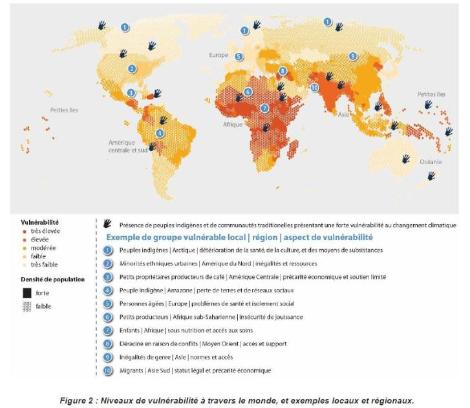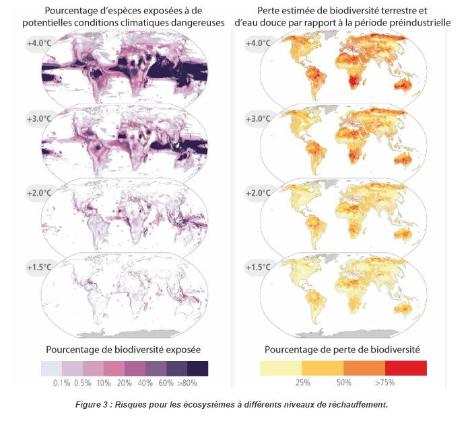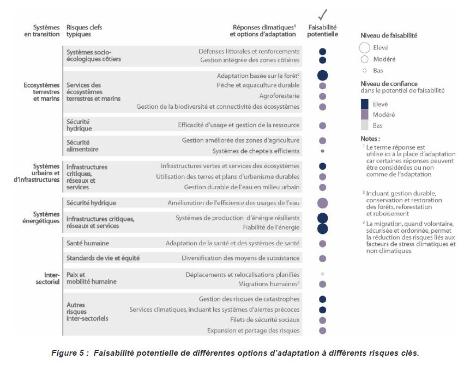Summary of the IPCC AR6 report II
Working Group II
February 2022
The IPCC (Intergovernmental Panel on Climate Change) is an organisation of 195 UN member states whose objective is to regularly assess the most advanced scientific knowledge on climate without bias. It brings together thousands of volunteer experts from around the world to assess, analyse and synthesise the many scientific studies on the subject. IPCC reports are central to international climate negotiations, such as COP21 in Paris in 2015 and COP26 in Glasgow in 2021. In 2007, the IPCC shared the Nobel Peace Prize with Al Gore. The IPCC is organised into three working groups. Group 1, whose report was published in August 2021, studies the scientific aspects of climate change. Group 2, which produced the report of which this is a summary, assesses risks and adaptation to climate change. Group 3 focuses on mitigation of climate change and is due to report in April 2022.
To download : ipcc_ar6_wgii_summaryforpolicymakers.pdf (1.3 MiB)
Introduction
Climate change is caused by emissions of greenhouse gases (GHGs) into the atmosphere. The resulting risks are the result of the interaction between climate hazards (e.g. heat waves, sea level rise, droughts), exposure and vulnerability of human societies and ecosystems. Exposure refers to the presence of systems (living species, ecosystems, human populations, infrastructure, etc.) that are susceptible to damage. Vulnerability, on the other hand, characterises the propensity of these systems to suffer damage, in other words their sensitivity to climate change and their capacity to cope with it.
Adapting to climate change involves reducing exposure and vulnerability in order to reduce its negative impacts. For human societies, adaptation is a concerted effort to adjust to the current or expected climate. Ecosystems can also adapt, through natural mechanisms such as species migration or evolution. The goal of adaptation is to achieve a more resilient state, i.e. one in which human and natural systems are able to maintain their essential functions and adaptive capacity in the face of climate shocks.
Climate, ecosystems and human societies are highly interdependent. Humans depend on well-functioning ecosystems for their survival, and can also help them adapt to climate change. Climate change is part of the broader context of many human impacts on the environment: loss of biodiversity, depletion of natural resources, degradation of soils and ecosystems. The interactions between climate, ecosystems and human societies are therefore essential to understand the risks associated with climate change and to define adaptation options.
The aim of this report is to understand and quantify the climate risks to human and natural systems, and to present effective, feasible, fair and equitable adaptation strategies. It is based on five Shared Socio-economic Pathways (SSP) scenarios presented by the first IPCC working group. These scenarios explore a wide range of future developments in terms of population, environmental policies, economic and technological development, translated into GHG emission trajectories.
Current and future impacts and risks
Observed impacts of climate change
Climate change has already caused widespread damage to nature and humans beyond natural climate variability. It is responsible for widespread deterioration of ecosystem functions and structures (terrestrial, freshwater, marine). The extent and magnitude of the impacts of climate change are greater than estimated in previous reports. Some damage, such as species extinction, is irreversible. Others, such as melting glaciers or damage to Arctic ecosystems from melting permafrost, will soon be irreversible.
The increase in the frequency and intensity of several types of extreme weather events (heat waves, heavy precipitation, droughts, etc.) is causing irreversible impacts by pushing natural and human systems beyond their adaptation limits. They also cause increasing displacement of populations. These events expose millions of people to food and water insecurity, to which children, the elderly and pregnant women are particularly susceptible (Figure 1). In this regard, about half of the world’s population experiences severe water shortages at least one month per year. In general, the most vulnerable human and natural systems are disproportionately affected.

Climate change is also having a negative impact on the physical and mental health of populations globally. Heat waves have led to mortality everywhere, and food- and water-borne diseases are on the rise. Diseases are appearing in areas that were previously unaffected.
Finally, in cities, climate change has impacted human health, livelihoods and infrastructure (water, sanitation, energy, transport). The impacts are concentrated on the economically and socially marginalised.
Vulnerability and exposure of ecosystems and humans

The vulnerability of ecosystems and human societies varies greatly across regions (Figure 2). It is highly dependent on the level of development, unsustainable use of oceans and land, the level of inequity and marginalisation, contemporary and past unjust societal patterns (such as colonialism), and governance.
The degradation of ecosystems reduces their capacity to adapt to climate change, but also that of the individuals, communities and societies that depend on them. Beyond the climate variable, the future vulnerability of ecosystems depends largely on past, present and future human developments. This includes unsustainable consumption and production as well as increasing population pressure and the continued overexploitation of land, ocean and water.
Between 3.3 and 3.6 billion people live in conditions of high vulnerability to global warming. Current unsustainable development patterns are increasing the exposure of ecosystems and humans to climate risks. Between 2010 and 2020, human mortality from floods, droughts and storms was 15 times higher in the most vulnerable regions. This vulnerability is exacerbated by injustice, as well as marginalisation related to gender, ethnicity or income level. This is particularly the case for indigenous peoples and local communities.
Short-term risks (2021-2040)
Whatever the PSS scenario, the risks associated with warming will inevitably increase in the short term. The report of the first working group showed that global warming has already reached 1.1°C, and that it could reach 1.5°C well before 2040. Even with less than 2°C of warming, some key risks are expected to result in widespread, invasive and potentially irreversible impacts, particularly in the case of high exposure and insufficient adaptation. Short-term actions limiting warming to around 1.5°C would therefore substantially reduce, but not eliminate, loss and damage to ecosystems and human societies compared to higher levels of warming.
Medium (2041-2060) and long-term (2081-2100) risks

From 2040 onwards, natural and human systems will face increased risks. The severity of the risks will depend on the level of warming and is not proportional to it (Figure 3). Ecosystems will face increasing extinction risks as warming increases. Endemic species are among the most threatened: their extinctions could increase tenfold between a global warming of +1.5°C and +3°C.
Water resources will also be impacted, posing many challenges for their management. For example, at +2°C, the amount of water available for irrigation from snowmelt could decrease by up to 20% in some regions. At +4°C, 10% of the world’s land areas could face extreme variations in river flows.
The risks to food security will be both quantitative (lower agricultural yields) and qualitative (contamination, reduced diversity, etc.). These impacts will increase with the increase in the frequency and severity of droughts, floods and heat waves, as well as with the rise in sea level. Deterioration of soil quality, disease development and loss of biomass will contribute to the loss of food production. Regions with few or no adaptation options, such as sub-Saharan Africa, South Asia, and Central and South America, are likely to experience high risks of malnutrition.
Climate change is also expected to exacerbate the physical and mental health problems that are currently observed. Exposure to heat waves will increase if global warming continues. Risks from water-, food- and vector-borne diseases will increase under any scenario without adaptation measures. The risk of dengue fever, for example, could affect a larger area of the globe and put billions of people at risk by the end of the century.
Cities, infrastructure and housing in coastal and high-temperature areas are particularly at risk. A 15 cm rise in sea level could increase the population at risk from extreme coastal flooding by 20%. This population would triple if the sea level rose by 1.4 m with the current population. In addition, between half and three quarters of the world’s population could be exposed to lethal combinations of heat and humidity by 2100.
Population displacement will increase as extreme events and sea level rise intensify, particularly in highly exposed regions with few adaptation options. This could lead to increased conflict.
Cascading risks

Climate risks are becoming increasingly complex to manage. Indeed, several hazards can affect an area or a sector of activity simultaneously. However, climate factors can also interact with non-climatic factors, creating cascading risks. For example, the increased frequency of heat waves and droughts can reduce agricultural yields, but also labour productivity, which in turn reduces returns.
As a result of these cascading risks, tipping points could be reached in sensitive ecosystems, such as those in the polar regions or the Amazon forest.
Extreme events will have impacts on societies and economies beyond borders. Indeed, supply chains and commodity flows could be affected, generating conflicts. For example, climate change is affecting the geographical distribution of fish populations as they move towards the poles. There is therefore a growing need for cross-border management of stocks. Not exceeding 1.5°C of warming is all the more crucial as any further increase in temperature, even temporarily, risks releasing carbon from ecosystems that currently store large quantities of carbon. These ecosystems have already been heavily impacted: increased fires, drying of peatlands, melting of permafrost, mass tree mortality. These impacts increase the GHG emissions of these ecosystems, and weaken their carbon storage capacity, making it even more difficult to limit warming.
Adaptation strategies
Much progress in adaptation planning and implementation has been made, including through increased political and public awareness. This has resulted in many benefits in agricultural productivity, innovation, health, food security, livelihoods, biodiversity conservation, which have contributed to reducing risks and damages. However, a large gap exists between current levels of adaptation and those required to cope with climate risks. Indeed, most of the observed adaptation is very limited: small-scale, unevenly distributed geographically, sector-specific, and in response to observed impacts. At the current rate of implementation of adaptation solutions, this gap will continue to grow. It is therefore important to accelerate the planning and implementation of solutions to close these gaps. In this respect, the next decade will be decisive.
Many adaptation measures exist in different sectors. Multi-sectoral approaches that also address social inequalities improve the effectiveness and feasibility of these measures. Adaptation also depends on mitigation (emission limitation), the other main pillar of the fight against climate change. Indeed, the greater the level of warming, the less effective the adaptation solutions will be. Finally, adaptation will reduce the risk of conflicts related to the impacts of climate change. For example, it helps to limit the tensions linked to forced migration for climatic reasons. Increasing people’s adaptive capacities broadens the range of choices when migration decisions are made, ensuring safe movement within and between countries. Similarly, the risk of conflict will be reduced by supporting the empowerment of women.

There are, however, limits to adaptation to climate change. Some have already been reached or are close to being reached, e.g. coral reefs, some warm seas, some coastal wetlands and some polar ecosystems. To combat global warming, global governance, appropriate policies, and considerable financial efforts are needed. Political decisions will have to go beyond electoral deadlines. Most funding, mainly public, has been allocated to mitigation, much less to adaptation. Yet adaptation is absolutely necessary. Adequate governance is all the more crucial as some actions that are beneficial in the short term may nevertheless prove inappropriate in the long term, such as the construction of sea walls. Adaptation responses must also be fair, equitable and therefore inclusive. Some of the mistakes of the past can be avoided through long-term planning. Accurate monitoring of actions taken at all levels of the public sphere is essential to achieve sustainable results. These actions should have clear objectives and priorities, and instruments to measure their impacts and progress accurately.
Conditions for climate change resilient development
Climate resilient development for natural and human systems
Observed impacts, projected risks, current trends in vulnerability and the limits to adaptation show that the need for action on climate-resilient development is more urgent than previously assessed in the IPCC Fifth Assessment Report. It is important to act now in a consistent manner, as each temperature increase reduces the chances of success.
The opportunities for climate-resilient development are not the same everywhere in the world. They depend on the national, regional and local context. There may be competing priorities between mitigation, adaptation and development. The balance between adaptation and mitigation depends on capacity, resources, vulnerability, culture, environment and development choices made in the past. Territorial vulnerability and social and economic inequalities exacerbate existing development challenges, especially in particularly vulnerable locations such as coastal areas, small islands and polar regions.
Inclusive governance based on equity, social and climate justice contributes to more effective and sustainable adaptation outcomes. Different actors must therefore reconcile divergent interests, values and worldviews. This requires developing partnerships with traditionally marginalised groups such as women, youth, indigenous peoples, or ethnic minorities. This process is facilitated by international cooperation and governments working with educational bodies, scientific institutions, the media, and investors. They are most effective when supported by favourable policies, institutions and resources (including financial). Legal and policy choices can also reduce structural vulnerabilities by addressing inequalities based on gender, ethnicity, disability, age, location and income.
Climate change is increasing the vulnerability of territories. The global trend of increasing urbanisation offers an opportunity for resilient development. This also includes adaptation in more rural areas, for example by encouraging the maintenance of peri-urban supply chains for goods and services. Furthermore, in 2020, nearly 896 million people were living in low-lying coastal areas. This figure could exceed 1 billion people by 2050. These people face climate-aggravated risks, including sea-level rise.
To reduce climate risk, decisions on future construction, urban planning, infrastructure and existing land use are urgently needed. Urban development must therefore respond to gaps in spatial planning and adaptation, while reducing the vulnerability of marginalised and low-income populations.
Financial efforts directed at the latter offer the greatest welfare gains.
Safeguarding biodiversity and preserving ecosystems
Safeguarding biodiversity and protecting and restoring ecosystems are essential components of climate-resilient development. Maintaining the resilience of biodiversity and ecosystem services will require the effective preservation of approximately 30-50% of the world’s land surface. This preservation will also have benefits for humans, including food production, water resources, livelihoods, health and well-being, while contributing to climate risk reduction. Biodiversity and ecosystem services have a limited capacity to adapt beyond 1.5°C of warming, which will make climate-resilient development even more difficult.
The scientific evidence is unequivocal: climate change is a threat to humanity and the planet. This report shows that climate risks are emerging earlier and more severely than expected. Ecosystems and human populations are being pushed to their limits and beyond. Any further delay in taking concerted global action will destroy any hope of a livable future.